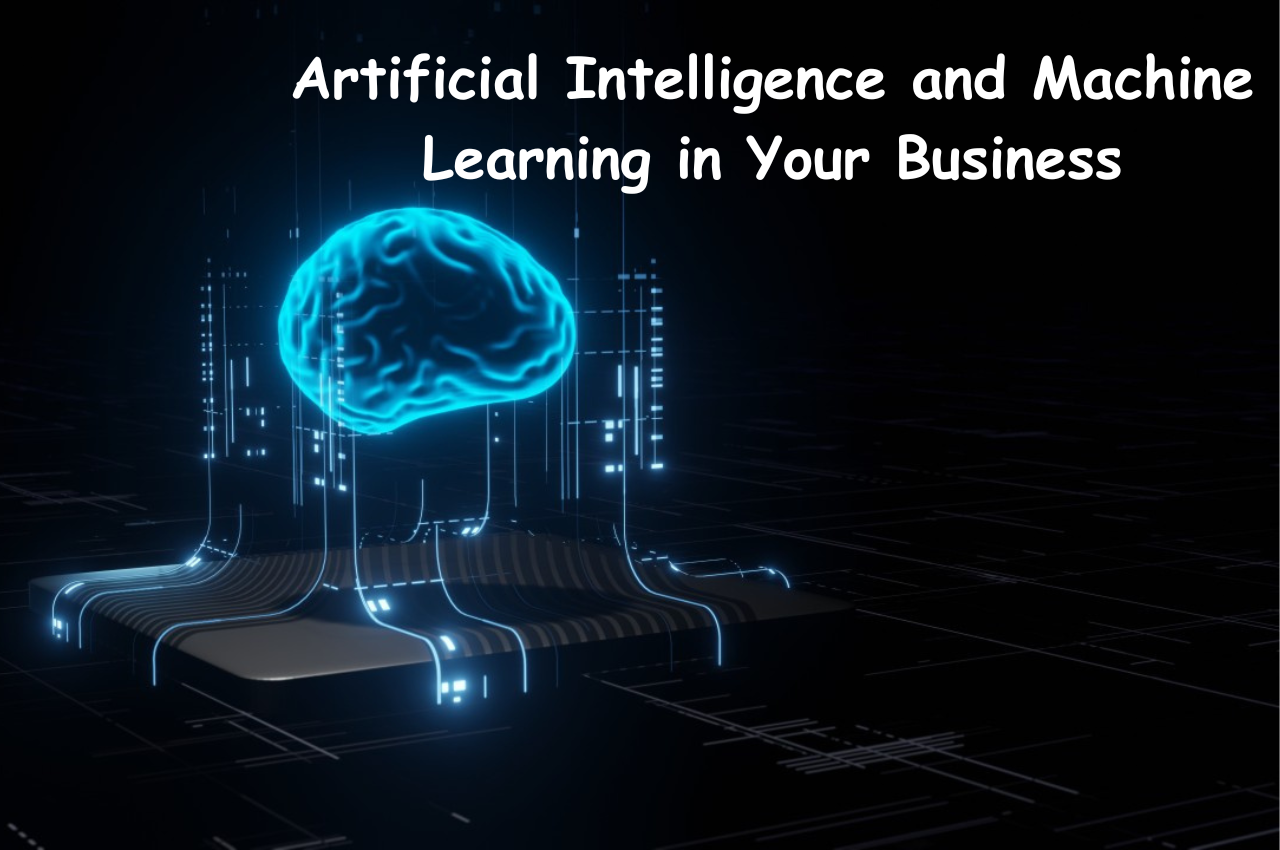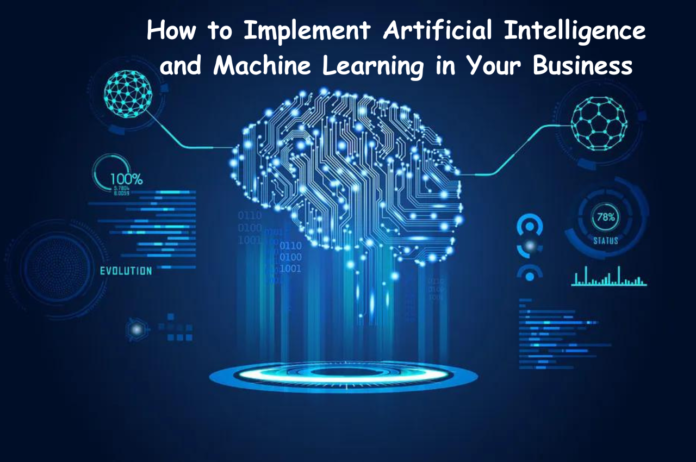Implementing artificial intelligence (AI) and machine learning (ML) in your business can significantly enhance efficiency, improve decision-making, and drive innovation. In today’s article, we outline the steps you can take to Implement Artificial Intelligence and Machine Learning in your business. Now let’s read the entire thing carefully-
Thank you for reading this post, don't forget to subscribe!Understanding Artificial Intelligence (AI) and Machine Learning (ML)
Artificial Intelligence (AI) and Machine Learning (ML) are often used interchangeably, but they refer to different concepts, though they are closely related.
Artificial Intelligence (AI): AI is a broad field of computer science that aims to create systems or machines that can perform tasks that would typically require human intelligence. These tasks include understanding natural language, recognizing patterns, solving problems, making decisions, and learning from experience. AI can be categorized into two types:
- Narrow AI: Also known as Weak AI, this type of AI is designed and trained for a specific task. Examples include virtual personal assistants like Siri or Alexa, recommendation systems, and image recognition software.
- General AI: Also referred to as Strong AI or AGI (Artificial General Intelligence), this is the type of AI depicted in science fiction, where machines possess general cognitive abilities similar to humans, capable of understanding, learning, and reasoning across different domains.
Machine Learning (ML): ML is a subset of AI that focuses on the development of algorithms and statistical models that enable computers to perform tasks without being explicitly programmed for each one. Instead, ML algorithms learn from data, identifying patterns and making decisions with minimal human intervention. ML can be further classified into different types:
- Supervised Learning: In this type of ML, the algorithm is trained on a labeled dataset, meaning each input is associated with the correct output. The algorithm learns to map inputs to outputs based on these examples.
- Unsupervised Learning: Here, the algorithm is given a dataset without labeled responses. Instead, it must find patterns or structure within the data on its own.
- Reinforcement Learning: This type of learning involves an agent learning to interact with an environment to achieve a goal. The agent receives feedback in the form of rewards or penalties based on its actions, allowing it to learn which actions lead to the best outcomes.
- Semi-Supervised Learning: This is a combination of supervised and unsupervised learning, where the algorithm is trained on a dataset that contains both labeled and unlabeled data.
- Deep Learning: Deep learning is a subfield of ML that uses neural networks with many layers (deep neural networks) to learn from large amounts of data. Deep learning has achieved remarkable success in tasks such as image and speech recognition, natural language processing, and playing games.
Implementing Artificial Intelligence and Machine Learning in Your Business
Implementing artificial intelligence (AI) and machine learning (ML) in your business can provide numerous benefits, ranging from automating repetitive tasks to gaining insights from data for better decision-making. Here’s a step-by-step guide to help you effectively integrate AI and ML into your business-
- Identify Business Challenges and Opportunities: Begin by identifying areas within your business where AI and ML can make a significant impact. This could include customer service, marketing, operations, supply chain management, or product development.
- Set Clear Objectives: Define specific goals and objectives you aim to achieve through AI and ML implementation. For example, reducing operational costs, improving customer satisfaction, or increasing sales revenue.
- Data Collection and Preparation: Collect relevant data from various sources within your organization. Ensure that the data is clean, structured, and properly labeled, as data quality is crucial for training accurate ML models.
- Choose the Right AI/ML Technologies: Select the appropriate AI and ML technologies based on your business needs and objectives. This could include machine learning algorithms, natural language processing (NLP), computer vision, or predictive analytics tools.
- Build or Acquire AI Models: Depending on your resources and expertise, you can either build custom ML models in-house or leverage pre-built AI solutions available in the market. Platforms like TensorFlow, PyTorch, or cloud-based services like Google Cloud AI or Amazon SageMaker can facilitate model development.
- Training and Testing: Train your AI models using historical data and validate their performance through rigorous testing. Evaluate different algorithms and parameters to optimize model accuracy and efficiency.
- Integration with Existing Systems: Integrate AI and ML capabilities seamlessly into your existing business systems and processes. This may involve collaboration between IT, data science, and business teams to ensure compatibility and smooth implementation.
- Continuous Monitoring and Improvement: Monitor the performance of deployed AI models in real-time and iterate on them as needed. Continuously collect feedback, analyze results, and refine your models to adapt to changing business conditions and evolving customer needs.
- Compliance and Ethical Considerations: Ensure that your AI and ML practices comply with relevant regulations, such as data privacy laws (e.g., GDPR) and ethical guidelines. Implement measures to mitigate bias, ensure transparency, and maintain accountability in your AI systems.
- Employee Training and Change Management: Provide training and support to employees who will be working with AI and ML technologies. Foster a culture of innovation and continuous learning to encourage adoption and acceptance of these tools within your organization.
- Measure ROI and Business Impact: Evaluate the return on investment (ROI) and assess the overall business impact of AI and ML implementation. Measure key performance indicators (KPIs) related to your initial objectives and adjust your strategies accordingly.
By following these steps, you can successfully implement artificial intelligence (AI) and machine learning (ML) technologies to drive innovation, efficiency, and competitive advantage in your business.
The Benefits of Artificial Intelligence (AI) and Machine Learning (ML) for Businesses
Artificial Intelligence (AI) and Machine Learning (ML) offer numerous benefits to businesses across various industries. Here are some key advantages-
Automation
AI and ML can automate repetitive tasks, saving time and resources for businesses. This includes data entry, customer service inquiries, and routine administrative tasks, allowing employees to focus on more strategic and creative endeavors.
 This leads to increased productivity and efficiency within the organization.
This leads to increased productivity and efficiency within the organization.
Enhanced Customer Experience
AI-powered chatbots and virtual assistants can provide round-the-clock customer support, improving response times and overall customer satisfaction. Personalization algorithms can also tailor products and services to individual customer preferences, increasing loyalty and retention.
Predictive Analytics
Machine learning algorithms can forecast trends and behaviors based on historical data, helping businesses anticipate customer demands, optimize inventory management, and minimize risks.
Cost Reduction
By automating processes and optimizing resource allocation, AI and ML technologies can reduce operational costs for businesses. This includes savings in labor, energy, and materials.
Fraud Detection and Security
AI algorithms can analyze patterns in data to identify suspicious activities and prevent fraud in real-time. Additionally, ML models can enhance cybersecurity by detecting and responding to cyber threats more effectively than traditional methods.
Optimized Marketing Strategies
AI-driven analytics can segment customers based on their preferences and behavior, allowing businesses to create targeted marketing campaigns. This leads to higher conversion rates and ROI on marketing investments.
Product Innovation
AI and ML enable businesses to gain insights into market trends and consumer preferences, facilitating the development of innovative products and services that meet evolving demands.
Streamlined Operations
AI can optimize supply chain management, logistics, and production processes, leading to smoother operations and reduced lead times.
Competitive Advantage
Businesses that leverage AI and ML technologies effectively can gain a significant competitive edge in their respective markets by staying ahead of trends, adapting quickly to changes, and delivering superior products and services to customers.
Challenges and considerations in Artificial Intelligence (AI) and Machine Learning (ML)
Artificial Intelligence (AI) and Machine Learning (ML) are powerful technologies with the potential to revolutionize various industries. However, they also come with their own set of challenges and considerations. Some of these include-
Data Quality
Machine Learning algorithms heavily rely on data for training. Poor quality data, such as incomplete, inaccurate, or biased data, can lead to flawed models and inaccurate predictions.
Bias and Fairness
AI and ML systems can inherit biases present in the data they are trained on, leading to unfair outcomes, particularly in sensitive areas like hiring, lending, and criminal justice. Addressing bias and ensuring fairness is a critical consideration in AI/ML development.
Privacy and Security
AI and ML systems often deal with sensitive data, raising concerns about privacy and security. It’s crucial to implement robust security measures to protect data and prevent unauthorized access or misuse.
Ethical Considerations
Artificial Intelligence (AI) and Machine Learning (ML) technologies raise various ethical dilemmas, such as the impact on employment, potential misuse of Artificial Intelligence for malicious purposes, and the widening gap between those who have access to AI technologies and those who do not.
Resource Constraints
Training and deploying complex AI and ML models often require significant computational resources, including high-performance computing infrastructure and specialized hardware like GPUs. Managing these resources efficiently is crucial, especially for organizations with limited budgets.
Human-AI Interaction
Designing intuitive and effective interfaces for interacting with AI and ML systems is essential to ensure usability and user acceptance. Understanding user needs and preferences is crucial for creating successful human-AI interaction experiences.
Successful Examples of AI Implementation in Business
AI implementation in business has become increasingly prevalent across various industries, offering benefits such as improved efficiency, enhanced decision-making, and personalized customer experiences. Here are some successful examples-
 E-commerce platforms like Amazon and streaming services like Netflix utilize AI algorithms to analyze user behavior and provide personalized recommendations. These systems improve customer engagement and increase sales by suggesting relevant products or content. Manufacturing companies leverage AI-driven predictive maintenance to anticipate equipment failures and schedule maintenance proactively, reducing downtime and minimizing costs. General Electric (GE) is a notable example of a company using AI for predictive maintenance in industries like aviation and power generation. Financial institutions employ AI algorithms to detect fraudulent activities in real-time by analyzing transaction patterns, user behavior, and other data points. Companies like PayPal and Mastercard utilize AI-powered fraud detection systems to safeguard against fraudulent transactions and protect their customers.
E-commerce platforms like Amazon and streaming services like Netflix utilize AI algorithms to analyze user behavior and provide personalized recommendations. These systems improve customer engagement and increase sales by suggesting relevant products or content. Manufacturing companies leverage AI-driven predictive maintenance to anticipate equipment failures and schedule maintenance proactively, reducing downtime and minimizing costs. General Electric (GE) is a notable example of a company using AI for predictive maintenance in industries like aviation and power generation. Financial institutions employ AI algorithms to detect fraudulent activities in real-time by analyzing transaction patterns, user behavior, and other data points. Companies like PayPal and Mastercard utilize AI-powered fraud detection systems to safeguard against fraudulent transactions and protect their customers.
Many businesses use AI-powered chatbots to handle customer inquiries, provide support, and automate routine tasks. Chatbots like those developed by IBM Watson or Google’s Dialogflow enable companies to offer 24/7 customer service, improve response times, and reduce operational costs. AI is used to optimize supply chain operations by forecasting demand, optimizing inventory levels, and streamlining logistics. Companies like Walmart and DHL utilize AI-driven systems to enhance supply chain efficiency, reduce costs, and improve customer satisfaction. AI algorithms are increasingly used in healthcare for tasks such as medical imaging analysis, diagnostics, and treatment planning. Companies like IBM Watson Health and Google Health are developing AI-powered tools to assist healthcare professionals in diagnosing diseases, identifying treatment options, and improving patient outcomes.
More Info: Challenges of Implementing Artificial Intelligence and Machine Learning
AI enables businesses to create personalized marketing campaigns by analyzing customer data, predicting preferences, and tailoring content accordingly. Companies like Coca-Cola and Starbucks utilize AI to deliver targeted advertisements, promotions, and product recommendations to individual customers. Organizations integrate AI-powered voice assistants like Amazon Alexa, Google Assistant, and virtual agents into their products and services to enhance user experiences and provide hands-free interaction. These assistants help users with tasks such as scheduling appointments, making reservations, and accessing information quickly.
AI technologies such as machine learning and natural language processing enable businesses to automate data analysis tasks, extract insights from large datasets, and make data-driven decisions more efficiently. Companies across various industries, including finance, marketing, and healthcare, utilize AI-powered analytics platforms to gain valuable insights and stay competitive. Automotive companies like Tesla and Waymo are developing autonomous vehicles powered by AI technology. These vehicles use sensors, cameras, and AI algorithms to perceive their environment, navigate roads safely, and make real-time driving decisions, paving the way for safer and more efficient transportation systems.
How Artificial Intelligence (AI) and Machine Learning (ML) Will Revolutionize Business Operations
Artificial Intelligence (AI) and Machine Learning (ML) are already revolutionizing business operations across various industries and are poised to continue doing so in the future. AI and ML algorithms can analyze vast amounts of data much faster and more accurately than humans. This capability enables businesses to derive valuable insights from data, identify patterns, trends, and correlations that were previously unseen, and make data-driven decisions across all aspects of operations.
By leveraging historical data, AI and ML algorithms can predict future outcomes with remarkable accuracy. This capability enables businesses to anticipate customer behavior, demand trends, equipment failures, and supply chain disruptions, allowing for proactive decision-making and risk mitigation strategies. AI and ML facilitate product innovation by analyzing market trends, consumer feedback, and competitor offerings. These technologies can help businesses identify unmet customer needs, optimize product features, and accelerate the product development lifecycle, leading to the creation of innovative and competitive products.
Overall, AI and ML technologies offer businesses unprecedented opportunities to optimize operations, drive innovation, and gain a competitive edge in today’s fast-paced and data-driven business landscape. As these technologies continue to evolve, their impact on business operations will only become more profound.
Technocommy is a connecting space, the leading growth and networking organization for business owners and leaders. Do I qualify?


